Egyptian Museum
The Museum of Egyptian Antiquities, known commonly as the Egyptian Museum or the Cairo Museum, in Cairo, Egypt, is home to an extensive collection of ancient Egyptian antiquities. It has 120,000 items, with a representative amount on display and the remainder in storerooms. Built in 1901 by the Italian construction company, Garozzo-Zaffarani, to a design by the French architect Marcel Dourgnon, the edifice is one of the largest museums in the region. As of March 2019, the museum was open to the public. In 2022, the museum is due to be superseded by the newer and larger Grand Egyptian Museum at Giza.
المتحف المصري (El-Matḥaf El-Masri) | |
 | |
 | |
| Established | 1902 |
|---|---|
| Location | Cairo, Egypt |
| Coordinates | 30°02′52″N 31°14′00″E |
| Type | History museum |
| Collection size | 120,000 items |
| Director | Sabah Abdel-Razek |
| Architect | Marcel Dourgnon |
| Website | www |
History


The Egyptian Museum of Antiquities contains many important pieces of ancient Egyptian history. It houses the world's largest collection of Pharaonic antiquities. The Egyptian government established the museum built in 1835 near the Ezbekieh Garden and later moved to the Cairo Citadel. In 1855, Archduke Maximilian of Austria was given all of the artifacts by the Egyptian government; these are now in the Kunsthistorisches Museum, Vienna.
A new museum was established at Boulaq in 1858 in a former warehouse, following the foundation of the new Antiquities Department under the direction of Auguste Mariette. The building lay on the bank of the Nile River, and in 1878 it suffered significant damage owing to the flooding of the Nile River. In 1891, the collections were moved to a former royal palace, in the Giza district of Cairo.[1] They remained there until 1902 when they were moved again to the current museum in Tahrir Square, built by the Italian company of Giuseppe Garozzo and Francesco Zaffrani to a design by the French architect Marcel Dourgnon.[2]
In 2004, the museum appointed Wafaa El Saddik as the first female director general.[3]
During the Egyptian Revolution of 2011, the museum was broken into, and two mummies were destroyed.[4][5] Several artifacts were also shown to have been damaged [6] and around 50 objects were lost.[7] Since then, 25 objects have been found. Those that were restored were put on display in September 2013 in an exhibition entitled Damaged and Restored. Among the displayed artifacts are two statues of King Tutankhamun made of cedar wood and covered with gold, a statue of King Akhenaten, ushabti statues that belonged to the Nubian kings, a mummy of a child, and a small polychrome glass vase.[8]
Sale Room for Antiquities
The Department of Antiquities (Service d'Antiquités Egyptien) operated a sale room (Salle de ventes) in the Egyptian Museum in Cairo from 1902 in room 56 on the ground floor, where original ancient Egyptian artworks and other original artefacts were sold. In addition, until the 1970s, dealers or collectors could bring antiquities to the Cairo Museum for inspection on Thursdays, and if museum officials had no objections, they could pack them in ready-made boxes, have them sealed and cleared for export. Many objects now held in private collections or public museums originated here. After years of debate about the strategy for selling the antiquities, the sale room was finally closed in November 1979.[9]
Interior design
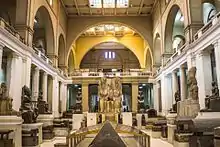
There are two main floors in the museum, the ground floor and the first floor. On the ground floor there is an extensive collection of large-scale works in stone including statues, reliefs and architectural elements. These are arranged chronologically in clockwise fashion, from the pre-dynastic to the Greco-Roman period.[10] The first floor is dedicated to smaller works, including papyri, coins, textiles, and an enormous collection of wooden sarcophagi. The numerous pieces of papyrus are generally small fragments, owing to their decay over the past two millennia. Several languages are found on these pieces, including Greek, Latin, Arabic, and ancient Egyptian. The coins found on this floor are made of many different metals, including gold, silver, and bronze. The coins are not only Egyptian, but also Greek, Roman, and Islamic. This has helped historians research the history of Ancient Egyptian trade.
Also on the ground floor are artifacts from the New Kingdom, the time period between 1550 and 1069 BC. These artifacts are generally larger than items created in earlier centuries. Those items include statues, tables, and coffins (sarcophagi). It contains 42 rooms; upon entering through the security check in the building, one looks toward the atrium and the rear of the building with many items on view from sarcophagi and boats to enormous statues.
On the first floor there are artifacts from the final two dynasties of Egypt, including items from the tombs of the Pharaohs; Thutmosis III, Thutmosis IV, Amenophis II, Hatshepsut, and the courtier Maiherpri, as well as many artifacts from the Valley of the Kings, in particular the material from the intact tombs of Tutankhamun and Psusennes I. Two special rooms contain a number of mummies of kings and other royal family members of the New Kingdom. On April 3, 2021, twenty-two of these mummies were transferred to the National Museum of Egyptian Civilization in Fustat in a grand parade dubbed The Pharaohs' Golden Parade.[11]

Memorial to famous Egyptologists
In the garden adjacent to the building of the museum, a memorial to famous egyptologists of the world is located. It features a monument to Auguste Mariette, surrounded by 24 busts of the following egyptologists: François Chabas, Johannes Dümichen, Conradus Leemans, Charles Wycliffe Goodwin, Emmanuel de Rougé, Samuel Birch, Edward Hincks, Luigi Vassalli, Émile Brugsch, Karl Richard Lepsius, Théodule Devéria, Vladimir Golenishchev, Ippolito Rosellini, Labib Habachi, Sami Gabra, Selim Hassan, Ahmed Kamal, Zakaria Goneim, Jean-François Champollion, Amedeo Peyron, Willem Pleyte, Gaston Maspero, Peter le Page Renouf[12] and Kazimierz Michałowski.
Gallery
 The Gold Mask of Tutankhamun, composed of 11 kg of solid gold
The Gold Mask of Tutankhamun, composed of 11 kg of solid gold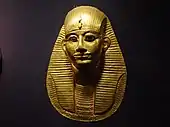 The Grave Mask of king Amenemope of the 21st dynasty
The Grave Mask of king Amenemope of the 21st dynasty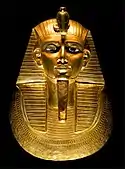 Mummy mask of Psusennes I
Mummy mask of Psusennes I Ramesses III prisoner tiles
Ramesses III prisoner tiles Colossal statue of Amenhotep III and Tiye
Colossal statue of Amenhotep III and Tiye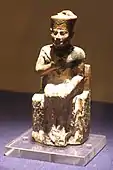 Figurine of Khufu
Figurine of Khufu Khafre Enthroned
Khafre Enthroned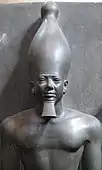 Statue of Menkaure
Statue of Menkaure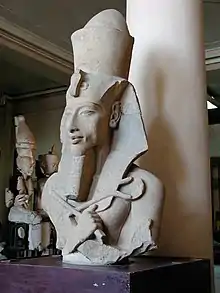 Bust of Akhenaten
Bust of Akhenaten Statue of Hatshepsut
Statue of Hatshepsut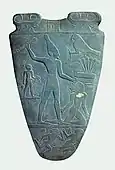 Narmer Palette
Narmer Palette Merneptah Stele
Merneptah Stele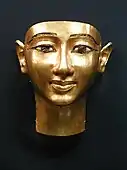 Mummy mask of Wendjebauendjed
Mummy mask of Wendjebauendjed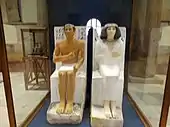 Rahotep and Nofret (2575-2550 BC)
Rahotep and Nofret (2575-2550 BC)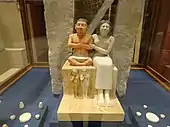 Dwarf Seneb with his wife (2400-2500 BC)
Dwarf Seneb with his wife (2400-2500 BC)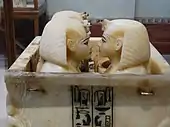 Canopic box from Tutankhamun's tomb
Canopic box from Tutankhamun's tomb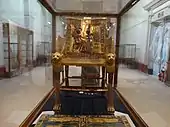 Throne of Tutankhamun
Throne of Tutankhamun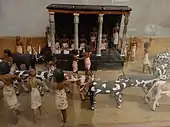 Wood sculptural composition depicting a cattle census scene (2000 BC)
Wood sculptural composition depicting a cattle census scene (2000 BC)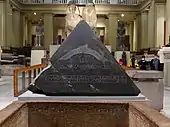 Pyramidion from the pyramid of Amenemhat III at Dashur
Pyramidion from the pyramid of Amenemhat III at Dashur
See also
- Egyptian Museum of Turin
- Egyptian Museum of Berlin
- National Museum of Egyptian Civilization
- List of museums with major collections of Egyptian antiquities
References
- "Supreme Council of Antiquities - Museums". www.sca-egypt.org. Archived from the original on 23 October 2017. Retrieved 28 February 2018.
- Kingsley, Patrick (27 January 2015). "Tutankhamun's famous home is undergoing a facelift (no glue involved)". the Guardian. Retrieved 28 February 2018.
- Düker, Ronald (11 July 2013). "Weltkultur in Gefahr". Die Zeit (in German). Retrieved 15 February 2019.
- "Looters destroy mummies during Egypt protests". ABC News. 29 January 2011. Retrieved 29 January 2011.
- "Vandals ravage Egyptian Museum, break mummies". Al-Masry Al-Youm. Archived from the original on 1 February 2011. Retrieved 30 January 2011.
- "Statues of Tutankhamun damaged/stolen from the Egyptian Museum". The Eloquent Peasant. Retrieved 30 January 2011.
- "Mummies set on fire as looters raid Egyptian museum - video - Channel 4 News". Channel4.com. 28 August 2013. Retrieved 8 January 2014.
- "Egyptian Museum exhibit puts spotlight on restored artefacts". Daily News Egypt. Retrieved 8 January 2014.
- Piacentini, Patrizia. "Notes on the History of the Sale Room of the Egyptian Museum in Cairo, in J. Helmbold-Doyé, T. Gertzen (Hrsg.), Mosse im Museum, Berlin 2017, pp. 75-87".
{{cite journal}}: Cite journal requires|journal=(help) - "The Egyptian Museum in Cairo". www.memphistours.com. Retrieved 13 November 2021.
- "Egypt's Pharaohs' Golden Parade: A majestic journey that history will forever record". Egypt Today. Retrieved 5 April 2021.
- "Dans la cour du musée du Caire, le monument de Mariette... et les bustes qui l'entourent". egyptophile.blogspot.nl. Retrieved 28 February 2018.
Further reading
- Brier, Bob (1999). The Murder of Tutankhamen: A True Story. ISBN 0-425-16689-9.
- Montet, Pierre (1968). Lives of the Pharaohs. World Publishing Company.
- Wafaa El-Saddik. The Egyptian Museum. Museum International. (Vol. 57, No.1–2, 2005).
- Tiradritti (editor), Francesco; De Luca (photographer), Araldo (1999). Egyptian Treasures from the Egyptian Museum in Cairo (Hardbook). New York. ISBN 0-8109-3276-8.
{{cite book}}:|last1=has generic name (help)Also published, with variant titles, in Italy and the UK. Reviews US ed. - Wilkinson, Toby (2020). A World Beneath the Sands: Adventurers and Archaeologists in the Golden Age of Egyptology (Hardbook). London: Picador. ISBN 978-1-5098-5870-5.
